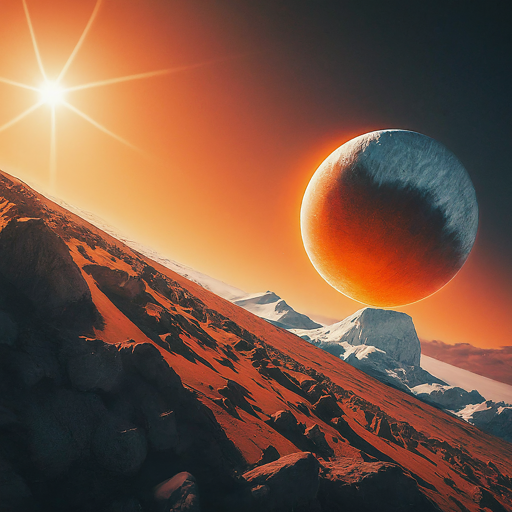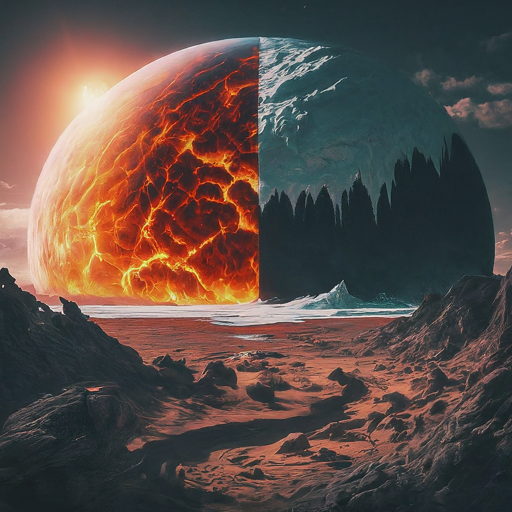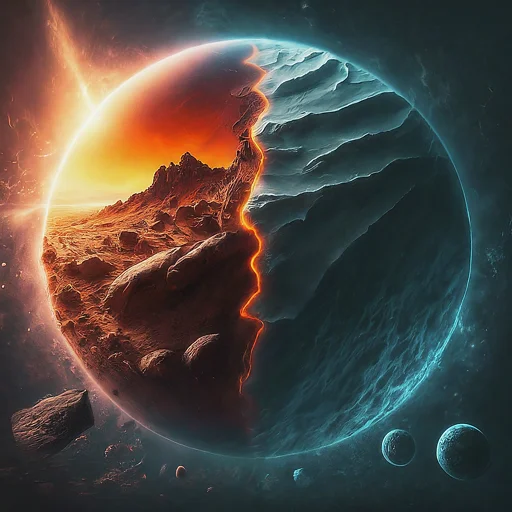You gaze upwards on a clear night and see the Moon, thinking it’s always the same side facing you. Ever wonder why our celestial neighbor doesn’t seem to rotate? You’re witnessing tidal locking in action! Get ready to have your mind blown as we explore how gravity can permanently lock planets in place, fixing one hemisphere in never-ending day while the other experiences perpetual night. From revealing how the Moon’s rotation became synchronized with its orbit around Earth, to looking at other examples like Europa and how tidal locking could impact alien climates, you’re about to discover some truly mind-bending cosmic quirks. So buckle up and get ready to see how gravitational forces can put planets in a spin – or lack thereof! This article will give you a front-row seat to one of the strangest phenomena in our solar system.
What Is Tidal Locking? Understanding Planetary Rotation and Revolution
Tidal locking is a super fascinating phenomenon where a moon or planet’s rotation has synced up with its revolution around another body. How cool is that? This means the same side of the moon or planet is always facing the body it orbits.
The Science Behind Tidal Locking
The gravity of the bodies a moon or planet orbits pulls on them and slightly distorts their shape. This is known as tidal forces. Over time, these forces actually slow the rotation of the moon or planet until its rotation matches its revolution, keeping the same face pointed at the body it orbits.
Examples in Our Solar System
The most well-known example is our moon, which is tidally locked to Earth. This is why we always see the same familiar face of the Moon. Mercury is also tidally locked to the Sun, as is Jupiter’s largest moon Ganymede. Many exoplanets are thought to be tidally locked to their stars as well. Here you can see how many moons are there in our solar systems.
The Effects of Tidal Locking
Being tidally locked has major consequences for a moon or planet. The side facing the body it orbits receives constant sunlight, while the opposite side remains in darkness. This results in extreme temperature differences across the surface. The illuminated side can reach up to 260°F, while the dark side plummets to -280°F! Here you can see the planet’s temperature.
Tidal locking also impacts geology and weather. Without rotation, there is no Coriolis effect to drive wind and weather. Mountains and craters on the illuminated side cast long shadows, while the dark side remains largely unmapped. Some exoplanets are so close to their stars that their atmospheres are thought to have evaporated on the hot side and frozen on the cold side.
While tidal locking may seem bizarre, it’s a natural result of gravity and tidal forces. By studying tidally locked worlds in our solar system and beyond, we gain insights into planetary formation and the effects of intense radiation and temperature extremes. Tidal locking continues to fascinate scientists and reveals the strange workings of the universe.


Famous Tidally Locked Planets: Exploring Worlds Stuck in a Single Day
Mercury, the Scorched World
Mercury is the innermost planet in our solar system and is locked in a 2:3 resonance with the Sun, meaning it rotates three times for every two orbits. This unique orbital configuration means that Mercury’s day lasts almost two Earth months! The surface facing the Sun sees temperatures hot enough to melt lead, while the dark side plummets to -173°C. What a dramatic difference within the same world!
The Moon, Our Loyal Companion
Our moon is tidally locked to Earth, with the same side always facing us. This is because its rotation period matches its orbital period, about 29.5 Earth days. The far side of the moon remained unseen until 1959 when the Soviet spacecraft Luna 3 transmitted the first images. The lunar nearside has a thinner crust and contains nearly all of the moon’s maria, while the farside has almost no maria. What mysteries remain to be discovered on the moon’s hidden face?
Unfamiliar Exoplanets
Astronomers have discovered several exoplanets that are tidally locked to their stars. Some, like Kepler-70b, orbit so closely that their surface temperatures are hot enough to vaporize iron! Others, like Gliese 581 c, orbit red dwarf stars and may be habitable. Tidally locked worlds offer an exciting frontier in the search for habitable exoplanets. What strange new vistas might open up on their perpetual day sides or in the twilight zones between day and night? The possibilities boggle the mind!
Tidal locking creates dramatic contrasts and secrets waiting to be uncovered. These worlds stuck in a perpetual day offer extremes of heat and cold and known and unknown terrains that continue to captivate our imaginations. What tales do their surfaces have to tell? Keep exploring the wonders of the universe!
Tidal Locking FAQs: Answering Common Questions About Planetary Rotation
Why does tidal locking happen?
When a planet orbits very closely to its star, the gravitational forces from the star can actually lock the planet’s rotation to match its orbital period. This is known as tidal locking. The tides the star raises on the planet actually cause friction that slows the planet’s rotation over time until its day equals its year. How cool is that?!
What planets experience tidal locking?
Some of the most well-known tidally locked worlds in our solar system are Mercury and our moon. Mercury orbits so closely to the sun that it has become tidally locked with its year, rotating just three times for every two orbits. And of course, our moon is tidally locked to Earth, showing us only one face. Exoplanets like Gliese 581 c, Kepler-70b and Proxima b are also thought to be tidally locked to their stars.
What’s it like on a tidally locked world?
If you lived on a tidally locked planet, you’d experience some pretty extreme conditions! One side of the planet would face the star constantly, baking in permanent daylight, while the opposite side would remain in darkness, frozen in eternal night. The temperature difference between these two sides could be hundreds of degrees! However, in between these two extremes there would be a sliver of habitability – a twilight zone in which temperatures may be suitable for life. How fascinating!
Can life exist on tidally locked planets?
The extreme temperature variations on most tidally locked planets are obviously problematic for life as we know it. However, some research suggests that the twilight zones of these worlds could potentially support life. With the right atmospheric conditions to transport heat and moisture, tidally locked planets may be able to foster habitable environments that life could adapt to. What an exciting possibility!
Tidal locking leads to a variety of peculiar planetary behaviors that are unlike anything we experience here on Earth. These strange worlds remain at the cutting edge of scientific discovery!
Conclusion
And there you have it – some of the amazing wonders of tidal locking across our cosmic neighborhood! From baking-hot Mercury to frigid Pluto, these celestial oddballs are stuck on one side forever. Makes you appreciate our own planet’s perfectly-timed spin, doesn’t it? Just imagine if we were tidally locked to the Sun – one hemisphere roasted in eternal daylight while the other lingered in permanent night. No gentle sunrises or sunsets for us! So next time you watch a gorgeous sunset, take a moment to appreciate our planet’s spin. Our rotation gives us the gift of a new day – and the promise of a new dawn just over the horizon. What a marvelous world we live in!

